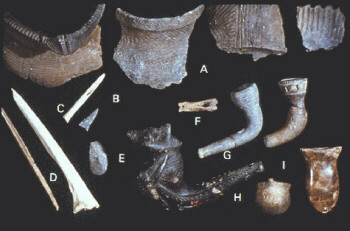

INTRODUCTION
Some time around 1000 B.C. the idea of using fired clay to make pottery containers began to spread into Ontario. This technology probably had little impact on the people of this province, however it is of enormous importance to archaeologists because although pots readily break in use, the broken pieces tend to last extremely well in the ground.
All over the world potters have found the semi-hard clay surface of freshly shaped pots (ie. before firing) to be an irresistible canvas for decoration and art. Since fashions and design preferences gradually change through time and from one people to another, the patterns of pottery decoration, and even the shape of the pots themselves provide valuable and accurate clues to the age and culture of the people who made them.
The Early Woodland people of Ontario were the first to use pottery in this province. In may other respects, people of the EARLY WOODLAND PERIOD (c. 900 B.C. - 300 B.C.) continued to live in much the same way as their predecessors of the Late Archaic. Like the Late Archaic people, they buried their dead with great ceremony, often including attractive and exotic artifacts in the graves. The Early Woodland people of Ontario appear to have been in contact with, or at least heavily influenced by their neighbours to the south - particularly the Adena people of the Ohio Valley.
So far no true Early Woodland tradition has been discovered in northern Ontario. The introduction of pottery into that part of the province does not seem to have occurred until much later.
MEADOWOOD COMPLEX (ca.900 B.C.-400 B.C.)
In many ways Meadowood is similar to the Glacial Kame complex of the Terminal Archaic period, sharing similarities in the way the dead were treated, and in many of the artifacts. However, the people of the Meadowood Complex were the first in Ontario to use pottery, thus this is the earliest Early Woodland complex in Ontario.
Meadowood sites have been found throughout southern Ontario and adjacent parts of New York State and southern Quebec. Related Early Woodland complexes have also been identified in parts of Michigan. Although a few Meadowood artifacts have been found on sites in the southern parts of northern Ontario, there is little evidence to suggest that Meadowood people consistently inhabited these areas.
SETTLEMENT
Relatively little information on the seasonal activities of Meadowood people is available. Concentrations of sites close to the shores of major lakes, particularly in sheltered and reedy bays, suggests that these people were attracted to warm, shallow water fishing areas during the spring and summer. Parts of nets, and numerous net sinkers have been found on Meadowood sites, showing that fishing was important. Ducks, turtles, frogs and shorebirds from the marshes and larger mammals from the surrounding forest probably supplimented their diet. These relatively large summer base camps were probably used year after year. Many are in close proximity to Meadowood cemeteries.
As the season changed, these people dispersed into small family hunting groups and moved inland. Archaeologists have identified a number of small fall/winter hunting camps where Meadowood people processed the deer they caught and prepared nuts from the rich hardwood forests for winter use. These camps tend to be located near the headwaters of small streams, well inland from the large lakes.
BURIAL
Meadowood people buried their dead in cemeteries close to their spring/summer fishing settlements. The dead were placed in graves and accompanied by a variety of objects in preparation for the afterlife. Copper beads, chert tools and equipment for starting fires were sometimes included with the bodies. Red ochre was sprinkled over many burials, symbolizing the renewal of life. Some Meadowood people were cremated, although cremation was used less frequently than in the Terminal Archaic period.
ARTIFACTS
The people of the Meadowood Complex used a distinctive group of artifacts.
Pottery
One of the hallmarks of Meadowood sites is the presence of thick, coil made pottery sherds from 'Vinette 1' pots. These sherds are coarsely tempered (ie. contains visible grit fragments) and are either smoothed on the inner and outer surface. The exterior of the pottery was sometimes roughened with a cord wrapped paddle. Vinette 1 pottery is always thick. Body sherds may be as much as one centimetre thick.
Meadowood Points and Cache Blades
These are the most distinctive and common Meadowood artifact. Meadowood points are thin, broad, side-notched points. They usually have square or almost square bases and are notched with small horizontal notches into the side of the point. These points were carefully thinned and finished through the removal of numerous small flakes from the surface of the artifact. These points were made by modifying 'cache blades'. Onondaga chert was the material of choice for these tools.
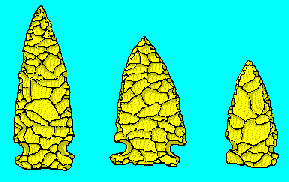
Cache blades are roughly triangular artifacts, usually with square bases and straight or convex sides. They are quite refined, needing only the most limited amount of additional flaking to modify them into a point, drill or knife. As their name suggests, cache blades have been found in large numbers or 'caches'. These caches sometimes accompanied burials as offerings; others appear to have been deliberately buried for retrieval and use at a later date. The abundance and uniformity of Meadowood cache blades has led some archaeologists to suggest that 'semi-specialized' craftsmen produced them for trade.
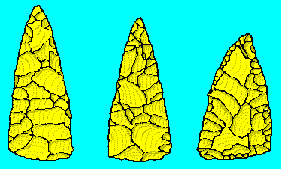
Drills and Scrapers
Drills and scrapers are a frequent find at Meadowood sites. Drills come in two forms; those that have been made by working a Meadowood point down into a narrow drill or awl-like point, and T-base or T-shaped drills made from cache blades. Hafted scrapers were made from Meadowood points. After the point had been snapped, the point end was reworked into an end scraper. These tools would have been used for a wide variety of boring, scraping and smoothing tasks.
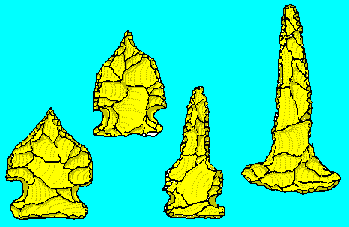
Birdstones and Gorgets
Meadowood people made two distinctive objects; pop-eye birdstones and trapezoidal gorgets. Birdstones are strange, stone artifacts which resemble stylized birds. These objects are usually made from high quality and visually attractive banded sedimentary rock which has been pecked, ground and polished to achieve the final form. It has been suggested that birdstones may have functioned as spear-thrower weights perhaps replacing bannerstones from the preceding Archaic period. Some birdstones have a drilled hole which runs down the length of the 'body' of the object. But whether functional, symbolic or merely decorative, the manufacture of these objects required quite an investment of labour and they were clearly valued items. Birdstones were often included as grave offerings.
Gorgets are flat, shaped and polished pieces of slate. The rock was carefully chosen so that the banding in the rock would be visible once it was polished. Meadowood gorgets tend to be slightly wider at one end than the other, flare slightly at the broad end, and may have slightly concave sides. Most have two holes, although some only have a single hole. As with birdstones the function of these objects is not known, although their frequent discovery as grave offerings suggests that they were worn as decoration.
MIDDLESEX COMPLEX (450 B.C. - 0 B.C.)
The Middlesex Complex is poorly known in Ontario, and virtually all of the information available has come from burials. These burials are, however, quite distinctive, containing a artifacts not generally found accompanying burials of other periods. These artifacts include ground and polished 'blocked-end' pipes of Ohio Firestone, and large, broad, bifacially worked leaf-shaped blades of exotic chert (Flint Ridge, Bayport, Upper Mercer etc.). These points are either stemmed or corner-notched. Smaller stemmed 'Adena' points have also been found in association with Middlesex Complex burials. Other artifacts include copper beads, copper celts and awls, keeled gorgets, paintstones and fire-making kits.
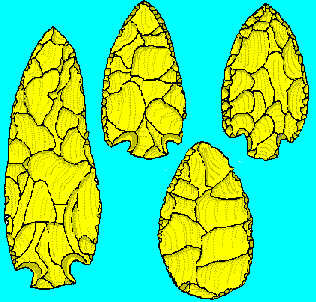
Some Middlesex burials were placed within mounds. In addition to the artifacts mentioned above, red ochre, fragments of basketry, reed matting, fabric and birchbark have been reported, indicating that these burials were quite complex and lavish in their preparation.
There seems little doubt that a connection existed between these Middlesex people and the Adena people of the Ohio Valley. Some archaeologists have argued that Middlesex represents the remains of an Adena group who, for unknown reasons, split off from their fellows to the south and moved north into the St. Lawrence River valley. Other prefer to view the presence of these distinctive burials as evidence of the widespread influence of Adena culture on local people through trade and the exchange of ideas.
The detailed examination of domestic settlements of this period is needed in order to help clarify this problem. Unfortunately, at present no sites which can clearly be related to the burials have either been discovered or examined in detail.
